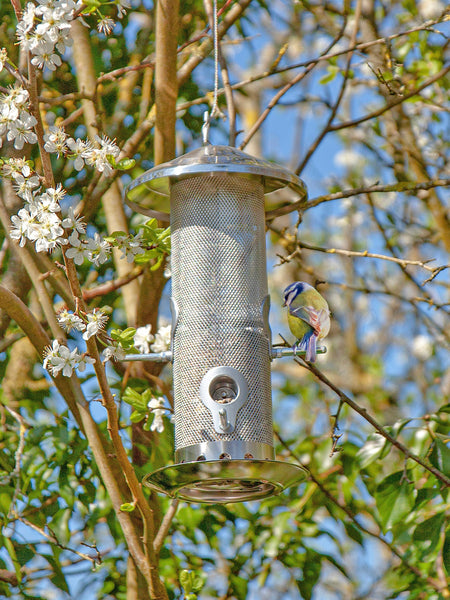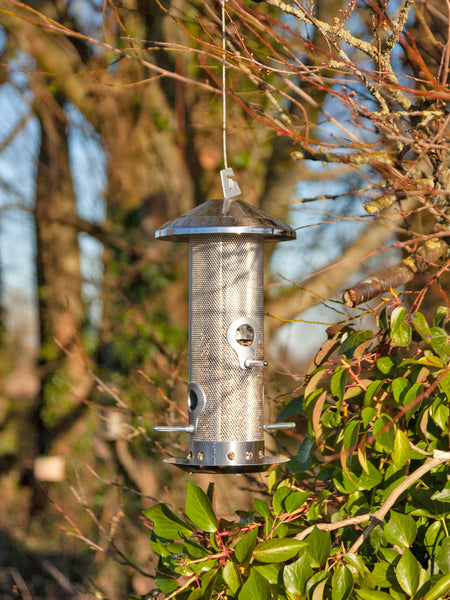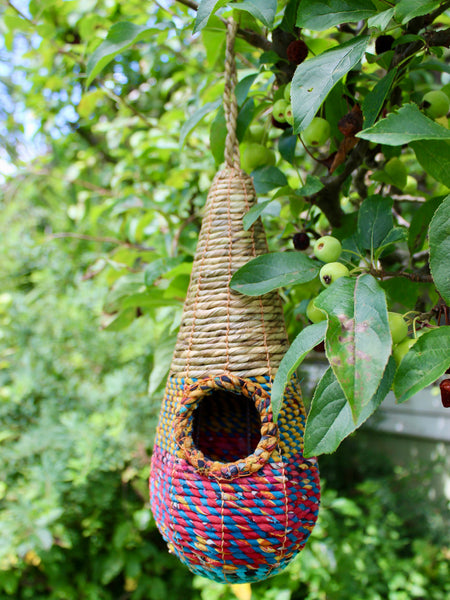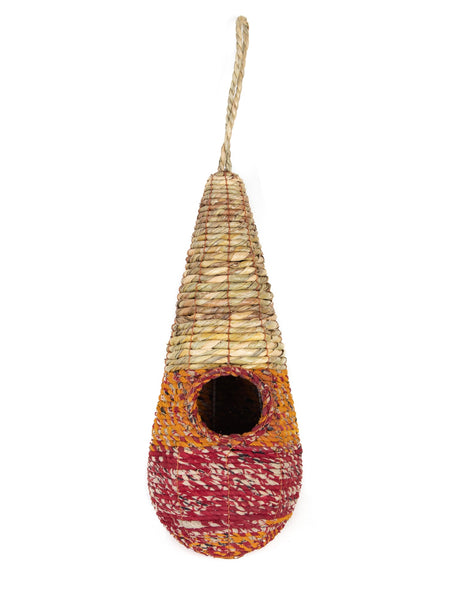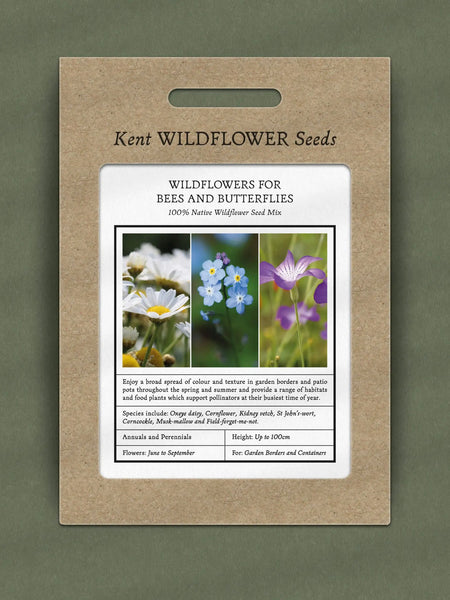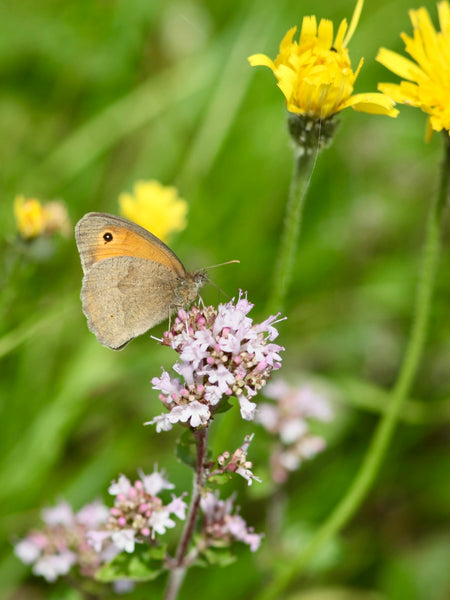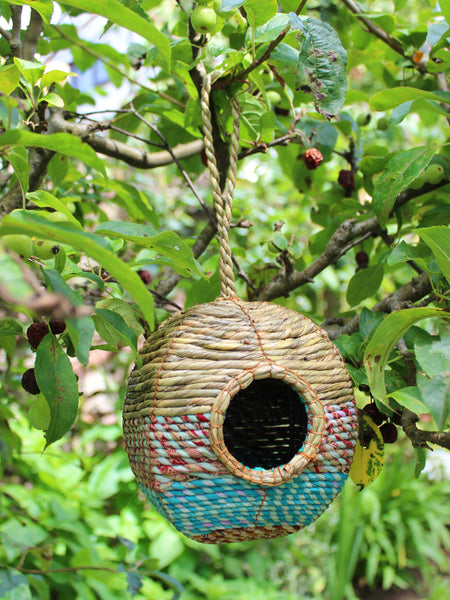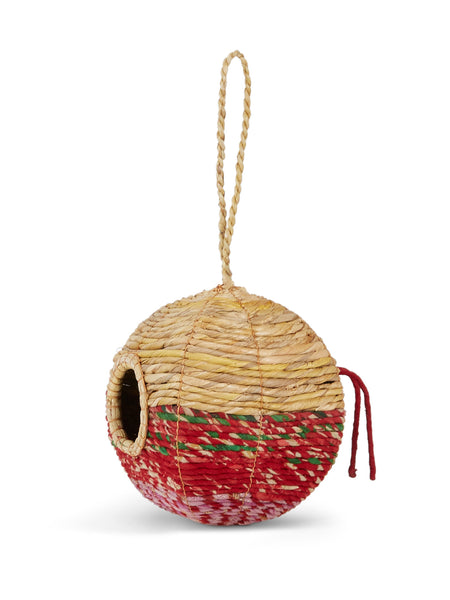Wild birds visiting feeders and bird baths bring us joy whilst providing a valuable reminder of our close connection to nature. By offering our feathered friends shelter, food, and water, we create a mutually beneficial relationship where we sustain them and they help us control common pests throughout the year.
Why is it important to feed garden birds?
You might think that birds are amply provided for by the food and shelter found in the countryside and parks. But when you consider that all of our gardens stitched together would fill a county the size of Somerset, you get a sense of the role we can play. Particularly in the winter, naturally occurring food such as berries, nuts, seeds, and insects are more scarce, and gardens offer an important supplementary source of nutrients and fresh water.
Our gardens have predators, of course, but these exist in most outdoor environments and shouldn’t deter us from making birds welcome. The following tips will help you maximise the number of feathered friends visiting your garden and ensure you keep them coming back.
What should I feed birds?
For the best chance of attracting a wide range of bird species, it’s best to offer a variety of different foods rich in fat, protein and carbohydrates.
-
Fat balls, suet pellets, and other high-energy foods are suitable for a variety of birds in winter. Softer-consistency fat balls and pellets are quicker and easier for birds to nibble or take away. Time is energy for small birds, and the faster they can feed, the better their chances of survival. Fatty foods are less needed in spring and summer, when they may also melt or go bad on warm days.
-
Blue tits, great tits, nuthatches, woodpeckers and jays adore peanuts. They should always be served in rigid mesh feeders that don’t allow whole nuts to be taken - whole peanuts can be a choking hazard for chicks. Peanuts can also be bought chopped into small pieces or processed into salt-free peanut butter, mixed with mealworms and dried fruits.
-
Sunflower hearts are great for greenfinches and chaffinches. Removing their dark husks makes the hearts less bulky and more straightforward for birds to take.
-
Nyger seeds, tiny black grains, are loved by goldfinches, greenfinches, siskins and redpolls, some of the showiest and most unusual garden birds.
-
Dried mealworms are famously appealing to robins, bluetits, wrens, blackbirds, and pied wagtails.
-
Dried and fresh fruit are a good source of natural sugar. Push a metal skewer through a fresh apple and hang it from a length of string, or cut it in half and mount it on a nail, taking care not to hurt yourself. If you have dogs or cats, don’t serve vine fruits, as they can be highly toxic if they eat them.
-
Seed heads and berries are natural foods for many species. Goldfinches flock to drying teasels in winter, and fieldfares will quickly strip a pyracantha bush of its berries. Leave as many in situ as possible, and the birds will find them.
-
You might be horrified by flying ants, caterpillars, spiders, worms and midges, but birds see invertebrates as a free meal and an essential part of their diet. If you unearth vine weevil larvae or find cabbage white caterpillars on your brassicas, leave them somewhere birds can humanely dispose of them for you. Robins, in particular, have a keen eye for a busy gardener!

Never offer birds food that’s been cooked, salted or processed and avoid bread, which is all three.
It’s best to avoid bird feeds with a high proportion of fillers, such as split peas, red dari, or whole wheat grains. Small birds rarely eat these and may discard them on the ground, where rodents and large birds, such as pigeons, might be attracted to them.
All birds have different feeding habits but will adapt, so try different feeders and foods until you find the combination that works best in your garden.
What sort of bird feeder should I use?
Feeders designed to hang are generally preferable to flat feeding stations such as bird tables*.
Seed feeders have a very fine mesh (2-3mm) to stop fine grains from dropping out, whereas nut and suet pellet feeders have a larger mesh (5-6mm) to allow birds to take small amounts of food at each visit. The largest mesh feeders (20mm plus) are for suet blocks: these can double as dispensers for wool and moss at nesting time.

Ensure all feeders have good drainage so that if the food gets wet, it will dry out quickly and not rot. The fewer nooks and crannies feeders have, the less stale food will build up and the easier it will be for you to clean.
Good hygiene is paramount to stop diseases like salmonella from spreading among the bird population. Remove any old food from your bird feeders each week and wash them in a bucket of hot water with mild detergent. Use a brush (I use a dedicated bottle brush), wear gloves and wash your hands thoroughly afterwards. I let my feeders air dry before refilling. Sweep up any fallen food to avoid attracting rodents.
Rather than filling your bird feeders to the brim every time, only add what your birds will consume in a few days. Top them up regularly to keep the food fresh and avoid waste.
* The RSPB advises against using flat bird feeders because of a possible link to diseases such as trichomonosis, a deadly illness for birds caused by a parasite. When sick birds drop food onto a flat surface, healthy birds may pick it up, thus causing infections to spread. If you see birds in your garden that might be sick, stop feeding them for 2-4 weeks and clean everything before starting again.

Where is the best place to put a bird feeder?
Site your feeders somewhere quiet and sheltered, where visitors won’t be disturbed or buffeted by strong winds. The birds should have some cover - perhaps a nearby tree or bush - but not so near that a predator could sneak up on them undetected. Birds prefer to feed where they have a good view of their surroundings.
A hanging position 4 - 6 feet above ground is good for birds and easy to refill. Some birds, such as blackbirds and robins, prefer to feed from the ground or feeders close to ground level. Ensure these feeders have perforated bases so they don’t collect water.
Birds are naturally suspicious of their surroundings, so it may take a little while to feel comfortable with a new feeder. Be patient, and they should come. If hungry birds haven’t visited you after a couple of months, it could be that something is putting them off, in which case, try an alternative spot or change the food you are offering.

What about water?
Water is critical for birds, especially when it’s naturally scarce during drought or freezing weather.
Shallow containers, such as plant pot saucers and upturned bin lids, make good improvised bird baths. Pop a few large pebbles in them to provide places for birds to perch and drink. In summer, you might also attract thirsty butterflies, bumble bees, and dragonflies.
As with bird feeders, hygiene is essential. Change the water daily and keep water sources clean, as algae will quickly build up.

Should I be worried……?
About cats - cats are hunters; if allowed out, even well-fed cats will hunt. It’s a behavioural thing, not a need for food. If you’re not prepared to keep your cat indoors full time, then the trick is to limit their opportunities to kill, whether by attaching a bell to their collar, keeping them in at night or siting feeders out of harm’s way. Some evidence suggests that playing with your cat for at least 10 minutes a day diminishes their desire to hunt. The general advice is that owning a cat or a garden where cats roam should not stop you from feeding birds, but do so with sensible precautions in place.
About squirrels - squirrels, and we are talking about grey squirrels here, are loved and loathed in equal measure. They’re a garden visitor we need to learn to live with, especially in towns and cities. Inquisitive, quick-witted and persistent, there are few bird feeders squirrels haven’t conquered. If you find them a nuisance, you could try offering them a separate source of easily accessible food in the hopes they’ll try less hard to access the tricky stuff! There are various baffles and contraptions on the market to deter squirrels from climbing onto feeders, and these may work for you - the only option is to try them out.
About rodents - rats and mice are a serious concern for many garden owners because they’ll eat far more than bird food if encouraged. I lost 2500 tulip bulbs to rats in one winter and can’t afford for that to happen again!
To reduce the risk of attracting rodents, always use the right food for the feeder, buy high-quality food with no fillers, and sweep up around your feeders regularly. Ironically, cats and visiting foxes should also act as a deterrent.
About larger birds - some garden owners are wary of attracting too many large birds, fearing they might bully the smaller ones and take all their food. While smaller birds are generally more vulnerable and need to feed more frequently, larger birds still have a place in our garden and can be fun to watch. I could write a book on the mischief our magpies get up to. Jays, pheasants, and non-native ring-necked parakeets are beautiful and showy and keen to make their presence known with their noisy calls.
If you want to give smaller birds an advantage at your feed dispensers, many models feature cages surrounding the primary feed holder, allowing access to only small birds. Some larger birds, such as starlings, may find cunning ways to access these, but they should deter birds such as crows, magpies and wood pigeons. If large birds appear to outnumber the small ones, it is a good idea to provide them with a low-level food source elsewhere in the garden in the hopes they’ll leave your hanging feeders alone.
You Might Also Enjoy

